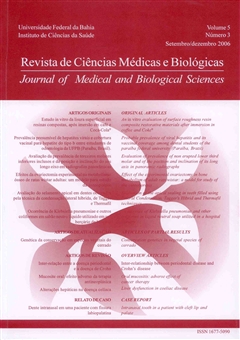Effect of the experimental ovariectomy in bone metabolism of adult rats wistar: a model for study of the osteoporosis
DOI:
https://doi.org/10.9771/cmbio.v5i3.4131Keywords:
Ovariectomy, osteoporosis, menopause.Abstract
The ovarian hormone privation causes functional and hormonal disorders, as sexual dysfunction, loss of libido, increase of osteoporosis risk and heart disease, lioprotein levels change and ponderal gain. Osteoporosis is a systemic skeletal disease characterized by an disorder between resorption and bone formation with a consequent increase in bone fragility. The objective of the present investigation was to describe the experimental ovariectomy (OVT) effects on the bone metabolism and on the ponderal gain of the adults wistar rats. Adult rats were under the OVT procedure or sham operated. After 30 days, blood was collectded for the quantitative serum estrogen and after 60 days the animals were sacrified for the serum and bone analysis. The dietary consumption and the weight increase were evaluated twice and once a week respectively. The OVT rats had statistically higher averages (p > 0,05) for the dietary consumption, weight gain and alkaline phosphatase activity in the serum and lower (p < 0,05) for the serum estrogen concentration, calcium content, radiodensity and bone proportional limit comparing to the sham-operated rats. Besides the quantitative analysis, the OVT rats had femurs with theirs surface containing deep resorption gaps, confirming that the ovariectomy rats are a great osteoporosis study model on post menopause women.Downloads
Download data is not yet available.
Downloads
Published
2006-02-03
How to Cite
Netto, C. C., Franco, M., Cunha, M. S. C. A. da, & Miyasaka, C. K. (2006). Effect of the experimental ovariectomy in bone metabolism of adult rats wistar: a model for study of the osteoporosis. Journal of Medical and Biological Sciences, 5(3), 231–238. https://doi.org/10.9771/cmbio.v5i3.4131
Issue
Section
ORIGINAL ARTICLES
License
The Journal of Medical and Biological Sciences reserves all copyrights of published works, including translations, allowing, however, their subsequent reproduction as transcription, with proper citation of source, through the Creative Commons license. The periodical has free and free access.


